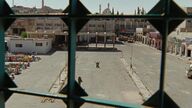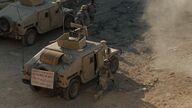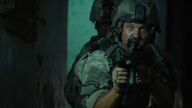The original log was written at the end of 2016, and the triggering sensitive words were collected as visible to themselves
Now post it again in the film review section, try to save
================================================== ==========================
Invited to write "Military Films in the Eyes of Combat Engineers", backup here
The biggest problem with the bomb disposal unit movie is that from the protagonist setting, they are not EOD personnel, nor do they belong to ordinary combat engineers or engineering units. They have mastered many skills such as street fighting, sniper operations, explosives dismantling, etc. A lonely man.
Especially in terms of the protagonist's setting, his character is very self-explanatory.
The conventional army is a huge machine with strict discipline and hierarchy. Starting from low-rank soldiers, people have been domesticated by various carrots and sticks (mainly sticks) into simple tools and executive elements. With the increase in military age and the promotion of military ranks, some people Will dare to re-exhibit one's own character and opinion, dare to ignore and violate the rules that many soldiers should abide by, and even take advantage of the differences in military ranks to act arbitrarily in a certain safe area.
But "how to achieve normal operation with other parts in an existing huge system", which is written into the lowest level of personality logic, will not be forgotten.
Next, let’s briefly talk about the military elements in the film.
The protagonist is set as a bomb disposal crew in the EOD team, and his two deputies may have received long-range sniper and street fighting training.
A French EOD bomb disposal personnel usually has served in the military for many years, with the rank of high-ranking non-commissioned officer or above. Only after serving in a conventional combat engineer company for 4-6 years and receiving professional non-commissioned officer training from the engineering school can he apply for relevant training and training. Position. However, there are not only ammunition disassembly personnel in the EOD unit. There are also a considerable number of low-level soldiers and non-commissioned officers with a low level of military rank and training to undertake search, identification, and other assistive tasks.
Title: IED scenes found on the street. normal
Robots usually belong to special units such as EOD and are used for reconnaissance of high-risk targets that have been highlighted, or for remote initiation. In order to maintain their work efficiency, special companies such as EOD usually do not continue to work on the front line most of the time, but are called to arrive after ordinary combat engineer units confirm that they are unable to solve them.
The opening shows a period of clearing and quarantine, which is the first action after suspicious objects are discovered. For those who are not familiar with the war zone, a similar scenario that is more likely to be encountered is the temporary isolation of forgotten luggage at the airport or station. Since the subway bombings in Madrid and London at the beginning of the 21st century, the military and police of various countries will default to explosives for unowned luggage in densely populated areas and carry out follow-up processing. The search dog confirms whether it contains explosives.
From the back of the film, it is obvious that the 360-degree isolation has not been achieved due to insufficient human resources. The basic training manual for combat engineers has corresponding guidance distances for unknown objects of different sizes. Correct isolation requires a lot of manpower. Therefore, it is often completed by a combat company equipped with light weapons and simple tools onboard and with sufficient human resources. .
The robot detected that the explosives are dominated by standard shells, which is consistent with the current situation in most theaters. Unlike terrorist crimes in urban environments, theaters and former theaters usually have a large amount of civilian standard ammunition lost. Therefore, most of the explosive parts of IEDs are still directly composed of standard ammunition, and there are ever-changing camouflage and detonation methods.
In addition to EOD/NEDEX, most non-commissioned officers of the combat company also need to be trained in ammunition recognition, so that they can give corresponding information when they are unable to deal with the need to call EOD.
The protagonist decides to detonate on the spot and estimate the safety distance is a common handling strategy for most IEDs in the theater. Destroying on the spot is the safest and most effective when the consequences are acceptable. The part of the artificial intervention caused by the damage of the trolley may be a plot conflict. In fact, even if the explosives need to be manually placed, it is more likely to be quickly placed by soldiers of a combat engineer company with basic blasting skills. Before detonating on the spot, if conditions permit, sandbags will be surrounded to absorb the impact and shrapnel. A large number of sandbags are also one of the basic vehicle-mounted tools of the combat engineer company.
Judging from the close-up of the explosive charge, it seems that the detonating cord is mixed with electrons to detonate. At present, the common French or US military standard explosives usually do not need to be covered with waterproof tape on the outside, and there is a more concise and clean connection method.
Using detonating cords or connecting detonators to connect multiple explosive blocks is basic infantry training and is not unique to EOD or combat engineers. However, with the current composition of the French multi-arms mixed unit, all types of work involving explosives are indeed only carried out by engineers or special companies (such as EOD) in the engineering units.
The team's first mission: crossing bombs.
In the current mission mode of the French army, the combat engineer company is sent to the battalion company-level mixed combat team in platoons or squads. If you need to call for EOD support, the person in charge of the combat engineer unit will describe the type and quantity as much as possible during the call.
At the same time, combat engineers with light weapons will work with other combatants to ensure the marking and control of the scene. The intervention of experts such as EOD is usually after realizing control on site.
The soldiers in the film reported suspicious cables, which is basically similar to the current actual situation. IED’s current mainstream remote initiation method is still cables, so combat engineer units and infantry units will have corresponding training to emphasize "whether cables are found", and have corresponding procedures to try to find cables as soon as possible and force the enemy The remote control personnel gave up their positions and escaped, thereby protecting high-value own units.
But the description of explosion-proof clothing is very light. The film shows a heavy-duty explosion-proof suit. In the French army, this type of explosion-proof suit is only equipped with explosives disposal units, while the combat engineer company is only equipped with light anti-explosion suits. However, even the light-weight explosion-proof clothing is still very heavy. After wearing it, it is not only impossible to walk like flying, but also difficult to change from a kneeling position to a standing position. Therefore, at least one person must be accompanied during the actual operation, so that the operator can pull the collar during kneeling operations such as mine sweeping with the probe to prevent accidental fall. Kneeling jobs in simple explosion-proof suits usually require rotation every 15-20 minutes.
For example, driving through the barriers in this scene is possible. In Mali, in 2014, soldiers of the First Engineering Corps broke through the barrier in Mali due to a self-destructive pickup. As the person in charge on the scene failed to make up his mind to open fire, the rest of the soldiers waited, resulting in eight casualties. Afterwards, the enemy is exposed or flees by tracking the cable. This is often the role of a combat company, but the handling of explosives is usually more cautious, and the situation of rashly pulling the cable is unlikely to happen.
The second task:
The role of the police at the beginning is precisely the positioning of ordinary engineers in the EOD work: using their own knowledge and experience to mark high-risk suspicious items, leaving them in place without operating them, but conveying as comprehensive information as possible to the specialized processing units, and Its work provides a good environment without interference.
Due to the location and quantity of the explosives, they cannot be detonated on the spot, so the detonating device needs to be dismantled and then transferred and destroyed. Due to the variety of initiating devices, the detonation work usually still starts with the initiating detonator of the main body of the explosive. The removed detonator is often placed in the sandbox for destruction nearby, while the explosives from which the detonator has been disassembled can be transferred and processed.
As always, the handling of suspicious explosives is often handled with care, even including lifting the suspicious suitcase from the ground to observe the bottom, which is often done with special tools. A situation such as kicking the rear hatch of a car is unlikely to happen.
As a soldier of the regular army, if he blatantly refuses to call during missions in the film, he may be severely punished. For example, he will be repatriated to the mainland immediately for investigation, follow-up promotion/training plan frozen, demoted or transferred to another freezer. Unit etc.
The third mission: destroy ammunition and desert combat
In fact, perhaps the most common form of work of the EOD team is to collect ammunition from various other channels-most of the time, it is the ammunition that is collected, and it is safely destroyed to prevent the loss of civilians from becoming an unstable factor.
In the basic training of the French army, blasting operations are usually done in groups, and the detonating device will be connected and evacuated quickly after the group leader checks and confirms that everything is ready. According to the operation process, for the failure of initiation or the suspension of the initiation, it is necessary to wait a long time before entering the operation area again. Therefore, in order to avoid operation failure, traditional fuse detonation or mixed detonation is usually adopted.
I don’t understand the part about encountering mercenaries and subsequent attacks, so skip it.
However, the continuous firing accuracy of the m2 heavy machine gun is actually quite low. We once aimed at a distance of 1200 meters and fired 100 rounds at a target of about 2*3, and only one shot made a hit. Combining the minigun made by a retired U.S. Special Forces member on the Internet with 12.7, this is actually a relatively normal level. If the general operation in the photo, the result can be imagined.
In addition, as a member of EOD, it is unlikely to receive sniper training, especially the use of 12.7 caliber sniper rifles. Soldiers who have not received special training for the first time using a 7.62 caliber sniper rifle usually cannot hit A4 paper-sized targets at a distance of 200 meters. Long-range shooting factors are more different.
Drinking footage after returning to the camp:
There is a lot of information indicating that in the camps of the war zone, the US soldiers have no access to alcoholic beverages.
The fourth task: indoor cleaning
The combat engineer company usually still has various environmental combat exercises at the squad and platoon level. But EOD neither undertakes such tasks nor does related exercises.
The urban revenge and the last demolition mission, omitted.
As engineers, whether it is a panacea conventional combat company or a special company that focuses on certain specific operations, they often work with platoons as the smallest unit, accompanied by the cooperation of infantry and armor. The engineers' own vehicle-mounted tools are also diverse and complex. The conventional vehicle-mounted tools of the French engineering combat units include various rods/drills and ropes to achieve marking and isolation, various chains, hinges, steel cables and other drag tools to achieve vehicle rescue, and various manual mine sweeping equipment to achieve explosions. Searching and screening of objects, as well as all kinds of own explosives to realize mine-laying and blasting operations, as well as various civil tools and so on. Therefore, the previous engineer version of armored vehicles welded various brackets to the outside of the car to fix the relevant tools. In actual use, the first-line units often chose to stuff them into the compartment because they were afraid of losing their tools. An improved version of the armored vehicle with multiple toolboxes welded to the outside.
Just like a Hummer Jeep in the movie, even if EOD has relatively few bomb disposal tools, it cannot be plugged.
View more about The Hurt Locker reviews











